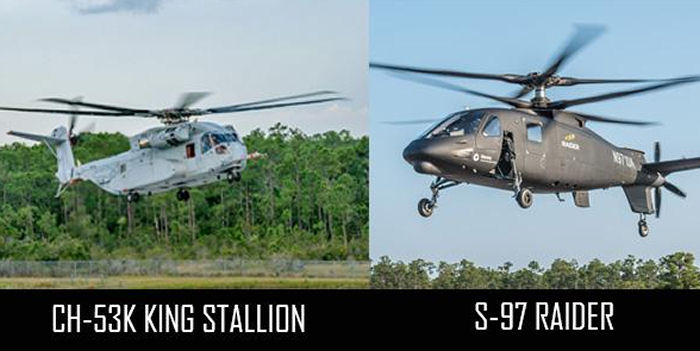
Lockheed Martin, February 17, 2016 - Between May and October, Sikorsky put air beneath the wheels of two new helicopters: the S-97 Raider light tactical helicopter, and the CH-53K King Stallion heavy lift aircraft.
Both aircraft represent next generation designs to support customers’ evolving missions and environments.
S-97 RAIDER
The prototype S-97 RAIDER aircraft took flight on May 22, 2015. The aircraft is designed for military and commercial applications, and features Sikorsky’s X2® rigid rotor co-axial design. Two counter-rotating rotor hubs — one stacked directly above the other — each spin four rotor blades.
Rigid rotor blades spinning in opposite directions within a co-axial design, when connected to the acceleration and speed braking effects of a variable pitch propeller, will generate twice the flight speed and twice the maneuverability of a conventional single main rotor helicopter.
The S-97 RAIDER’s 220 to 240 knot flight speed, and extraordinary maneuverability in the hover and low speed regimes will dramatically change the way that military aviators can fly and fight with helicopters.
CH-53K King Stallion
Oct. 27, 2015, marked the first flight of the CH-53K heavy lift helicopter built for the U.S Marine Corps. The Kilo’s outward similarity to its CH-53E predecessor stems from the need to fit inside U.S. Navy ships.
But the new aircraft can carry more than three times the external load of its predecessor.
The CH-53K aircraft can lift more than 12,246 kg (27,000 pounds) over a mission radius of 110 nautical miles under “high-hot” ambient conditions.
Technology enablers for increased lift include:
- Three 7,500-shaft-horsepower class GE38-1B engines
- A split torque transmission design that more efficiently distributes engine power to the main rotors
- Fly-by-wire flight controls
- Fourth-generation composite rotor blades for enhanced lift; and a composite airframe structure for reduced weight.
Over the course of a three-year flight test program, four flight test helicopters will fully expand the King Stallion aircraft’s flight envelope.
he U.S. Marine Corps is expected to achieve initial operational capability in 2019.
Both aircraft represent next generation designs to support customers’ evolving missions and environments.
S-97 RAIDER
The prototype S-97 RAIDER aircraft took flight on May 22, 2015. The aircraft is designed for military and commercial applications, and features Sikorsky’s X2® rigid rotor co-axial design. Two counter-rotating rotor hubs — one stacked directly above the other — each spin four rotor blades.
Rigid rotor blades spinning in opposite directions within a co-axial design, when connected to the acceleration and speed braking effects of a variable pitch propeller, will generate twice the flight speed and twice the maneuverability of a conventional single main rotor helicopter.
The S-97 RAIDER’s 220 to 240 knot flight speed, and extraordinary maneuverability in the hover and low speed regimes will dramatically change the way that military aviators can fly and fight with helicopters.
CH-53K King Stallion
Oct. 27, 2015, marked the first flight of the CH-53K heavy lift helicopter built for the U.S Marine Corps. The Kilo’s outward similarity to its CH-53E predecessor stems from the need to fit inside U.S. Navy ships.
But the new aircraft can carry more than three times the external load of its predecessor.
The CH-53K aircraft can lift more than 12,246 kg (27,000 pounds) over a mission radius of 110 nautical miles under “high-hot” ambient conditions.
Technology enablers for increased lift include:
- Three 7,500-shaft-horsepower class GE38-1B engines
- A split torque transmission design that more efficiently distributes engine power to the main rotors
- Fly-by-wire flight controls
- Fourth-generation composite rotor blades for enhanced lift; and a composite airframe structure for reduced weight.
Over the course of a three-year flight test program, four flight test helicopters will fully expand the King Stallion aircraft’s flight envelope.
he U.S. Marine Corps is expected to achieve initial operational capability in 2019.
See also |
Sikorsky S-97 Raider
Sikorsky CH-53K King Stallion
Lockheed Martin Completes Acquisition of Sikorsky




